Critical Challenges in the Anodizing Process of Aluminium–Silicon Cast Alloys—A Review
Abstract
:1. Introduction
- Initially, aluminum cations (Al3+) are generated from the aluminum substrate acting as the anode.
- In the presence of a strong electric field, aluminum cations undergo migration toward the cathode, while anions present in the aqueous solution (such as O2−, OH−, and electrolyte anions) move in the opposite direction. At the interfaces of the metal/oxide and oxide/electrolyte, the Al3+ cations react with the anions, giving rise to the formation of aluminum oxide (Al2O3).2Al3+ + 3O2− = Al2O3 (at the metal/oxide interface)2Al3+ + 3H2O = Al2O3 + 6H+ (at the oxide/electrolyte interface)
- Simultaneously, at the oxide/electrolyte interface, the aluminum oxide has the potential to dissolve within the electrolyte, resulting in the creation of a porous layer. The following equation governs this chemical dissolution process:Al2O3 + 6H+ = 2Al3+ + 3H2O
2. Effect of the Alloy Second-Phase Particles
- At 650 °C, Primary Al15(Mn, Fe)3Si2 (commonly referred to as sludge) precipitates.
- At 600 °C, Al15(Mn, Fe)3Si2 and/or Al5FeSi precipitate.
- At 550 °C, eutectic Al+Si, Al5FeSi, and Mg5Si precipitate.
- At 500°C, Al2_22Cu and more complex phases precipitate [35].
2.1. Silicon Particles
- Formation of oxygen gas-filled voids: When the oxide front comes into contact with the silicon phase, it causes the creation of both SiO2 and gaseous oxygen because of the semiconductor characteristics of the Si-O bond. As a result, voids filled with oxygen gas appear near the Si particles [38,39,40], as depicted in Figure 3.
- Formation of un-anodized regions: Un-anodized regions form when the oxide layer does not completely surround the Si phase, potentially due to its morphology or reduced particle spacing. As a result, the eutectic silicon phase functions as a barrier, protecting the nearby Al matrix from the oxide layer and thereby preserving it in an un-anodized state. Residual metallic Al phases are primarily observed under or among large, interconnected Si eutectic particles [39,40].
2.2. Iron-Rich Intermetallic Particles
2.3. Copper-Rich Intermetallic Particles
3. Influence of Processing Prior to the Anodizing Process
3.1. Casting Process
3.2. Machining Operations
4. Influence of Anodizing Parameters
4.1. Electrolyte
4.2. Anodizing Duration and Electrolyte Temperature
4.3. Voltage and Current
5. Influence of Post-Treatment
6. Perspectives and Future Outlook
Author Contributions
Funding
Conflicts of Interest
References
- Henley, V.F. Anodic Oxidation of Aluminium and Its Alloys: The Pergamon Materials Engineering Practice Series; Elsevier: Amsterdam, The Netherlands, 2013. [Google Scholar]
- Sheasby, P.G.; Pinner, R.; Wernick, S. The Surface Treatment and Finishing of Aluminium and Its Alloys; ASM international: Materials Park, OH, USA, 2001; Volume 1. [Google Scholar]
- Asensio-Lozano, J.; Suárez-Peña, B.; Voort, G.F.V. Effect of processing steps on the mechanical properties and surface appearance of 6063 aluminium extruded products. Materials 2014, 7, 4224–4242. [Google Scholar] [CrossRef] [PubMed]
- Runge, J.M. The Metallurgy of Anodizing Aluminum; Springer International Publishing: Cham, Switzerland, 2018. [Google Scholar]
- Diggle, J.W.; Downie, T.C.; Goulding, C.W. Anodic oxide films on aluminum. Chem. Rev. 1969, 69, 365–405. [Google Scholar] [CrossRef]
- Thompson, G.E. Porous anodic alumina: Fabrication, characterization and applications. Thin Solid Films 1997, 297, 192–201. [Google Scholar] [CrossRef]
- O’sullivan, J.P.; Wood, G.C. The morphology and mechanism of formation of porous anodic films on aluminium. Proc. R. Soc. London. Math. Phys. Sci. 1970, 317, 511–543. [Google Scholar]
- Valiev, R.Z.; Zhilyaev, A.P.; Langdon, T.G. Bulk Nanostructured Materials: Fundamentals and Applications; John Wiley and Sons: Hoboken, NJ, USA, 2013. [Google Scholar]
- Abrahami, S.T. Cr (VI)-Free Pre-Treatments for Adhesive Bonding of Aerospace Aluminium Alloys. Ph.D. Thesis, Delft University of Technology, Delft, The Netherland, 2016. [Google Scholar]
- Voon, C.H.; Derman, M.N.; Hashim, U.; Ahmad, K.R.; Foo, K.L. Effect of temperature of oxalic acid on the fabrication of porous anodic alumina from Al-Mn alloys. J. Nanomater. 2013, 2013, 167047. [Google Scholar] [CrossRef]
- Paz Martínez-Viademonte, M.; Abrahami, S.T.; Hack, T.; Burchardt, M.; Terryn, H. A review on anodizing of aerospace aluminum alloys for corrosion protection. Coatings 2020, 10, 1106. [Google Scholar] [CrossRef]
- Sheasby, P.G.; Wernick, S.; Pinner, R. Surface Treatment and Finishing of Aluminum and Its Alloys; ASM International: Detroit, MI, USA, 1987; Volumes 1 and 2. [Google Scholar]
- Emel, R.; Koncz-Horváth, D.; Török, T.I. Anodic Film Changes during Anodizing Commercial Pure Aluminum; Doktorandusz Almanach: Miskolc, Hungary, 2023; Volume 1. [Google Scholar]
- Thompson, G.E.; Wood, G.C. Anodic Films on Aluminium. In Treatise on Materials Science and Technology; Elsevier: Amsterdam, The Netherlands, 1983; Volume 23, pp. 205–329. [Google Scholar]
- Takahashi, H.; Nagayama, M. The determination of the porosity of anodic oxide films on aluminium by the pore-filling method. Corros. Sci. 1978, 18, 911–925. [Google Scholar] [CrossRef]
- Chesterfield, L.; Runge, J. Connecting theory to practice, the science of successfully anodizing aluminum die castings. In Proceedings of the 19th Annual Technical Conference and Exposition of the Aluminum Anodizers Council, USA, 2010. [Google Scholar]
- Chen, J.; Wen, F.; Liu, C.; Li, W.; Zhou, Q.; Zhu, W.; Zhang, Y.; Guan, R. The microstructure and property of Al–Si alloy improved by the Sc-microalloying and Y2O3 nano-particles. Sci. Technol. Adv. Mater. 2021, 22, 205–217. [Google Scholar] [CrossRef] [PubMed]
- Huang, J.-M.; Zhao, H.; Chen, Z. Microstructure and properties of A356 alloy wheels fabricated by low-pressure die casting with local squeeze. J. Mater. Eng. Perform. 2019, 28, 2137–2146. [Google Scholar] [CrossRef]
- Martin, J.H.; Yahata, B.D.; Hundley, J.M.; Mayer, J.A.; Schaedler, T.A.; Pollock, T.M. 3D printing of high-strength aluminium alloys. Nature 2017, 549, 365–369. [Google Scholar] [CrossRef]
- Cabrini, M.; Lorenzi, S.; Pastore, T.; Testa, C.; Manfredi, D.; Lorusso, M.; Calignano, F.; Pavese, M.; Andreatta, F. Corrosion behavior of AlSi10Mg alloy produced by laser powder bed fusion under chloride exposure. Corros. Sci. 2019, 152, 101–108. [Google Scholar] [CrossRef]
- Rogov, A.B.; Lyu, H.; Matthews, A.; Yerokhin, A. AC plasma electrolytic oxidation of additively manufactured and cast AlSi12 alloys. Surf. Coatings Technol. 2020, 399, 126116. [Google Scholar] [CrossRef]
- Pezzato, L.; Dabalà, M.; Gross, S.; Brunelli, K. Effect of microstructure and porosity of AlSi10Mg alloy produced by selective laser melting on the corrosion properties of plasma electrolytic oxidation coatings. Surf. Coatings Technol. 2020, 404, 126477. [Google Scholar] [CrossRef]
- Zhu, B.; Zanella, C. Hardness and corrosion behaviour of anodised Al-Si produced by rheocasting. Mater. Des. 2019, 173, 107764. [Google Scholar] [CrossRef]
- Lien, H.-H.; Mazumder, J.; Wang, J.; Misra, A. Microstructure evolution and high density of nanotwinned ultrafine Si in hypereutectic Al-Si alloy by laser surface remelting. Mater. Charact. 2020, 161, 110147. [Google Scholar] [CrossRef]
- Mora-Sanchez, H.; Olmo, R.D.; Rams, J.; Torres, B.; Mohedano, M.; Matykina, E.; Arrabal, R. Hard anodizing and plasma electrolytic oxidation of an additively manufactured Al-Si alloy. Surf. Coatings Technol. 2021, 420, 127339. [Google Scholar] [CrossRef]
- Wang, P.; Ma, Q.; Yuwen, Q.; Li, J. The differences in the formation mechanism of PEO and CPED composited ceramic coatings on Al-12Si alloy. J. Alloys Compd. 2019, 788, 61–66. [Google Scholar] [CrossRef]
- Scampone, G.; Timelli, G. Anodizing Al–Si foundry alloys: A critical review. Adv. Eng. Mater. 2022, 24, 2101480. [Google Scholar] [CrossRef]
- Konieczny, J.; Dobrzański, L.A.; Labisz, K.; Duszczyk, J. The influence of cast method and anodizing parameters on structure and layer thickness of aluminium alloys. J. Mater. Process. Technol. 2004, 157, 718–723. [Google Scholar] [CrossRef]
- Tsangaraki-Kaplanoglou, I.; Theohari, S.; Dimogerontakis, T.; Wang, Y.; Kuo, H.H.; Kia, S. Effect of alloy types on the anodizing process of aluminum. Surf. Coat. Technol. 2006, 200, 2634–2641. [Google Scholar] [CrossRef]
- Shin, J.S.; Kim, B.H.; Lee, S.M. Effects of physical melt treatments on microstructural evolution and anodizing characteristics of Al-Si casting alloys. In Materials Science Forum; Trans Tech Publications Ltd.: Zurich, Switzerland, 2011; Volume 695, pp. 243–246. [Google Scholar]
- Chauke, L.; Möller, H.; Govender, G. Anodising of aluminium alloy plates from different series produced by rheo-high pressure die casting. Solid State Phenom. 2015, 217, 247–252. [Google Scholar] [CrossRef]
- B108/B108M; Aluminum and Magnesium Alloys Annual. ASTM Standards: West Conshohocken, PE, USA, 2018; Volume 02.02.
- Arrabal, R.; Mingo, B.; Pardo, A.; Mohedano, M.; Matykina, E.; Rodríguez, I. Pitting corrosion of rheocast A356 aluminium alloy in 3.5 wt.% NaCl solution. Corros. Sci. 2013, 73, 342–355. [Google Scholar] [CrossRef]
- Mingo, B.; Arrabal, R.; Pardo, A.; Matykina, E.; Skeldon, P. 3D study of intermetallics and their effect on the corrosion morphology of rheocast aluminium alloy. Mater. Charact. 2016, 112, 122–128. [Google Scholar] [CrossRef]
- Samuel, A.M.; Samuel, F.H. Modification of iron intermetallics by magnesium and strontium in Al-Si alloys. Int. J. Cast Met. Res. 1997, 10, 147–157. [Google Scholar] [CrossRef]
- Fratila-Apachitei, L.; Duszczyk, E.J.; Katgerman, L. Vickers microhardness of AlSi (Cu) anodic oxide layers formed in H2SO4 at low temperature. Surf. Coatings Technol. 2003, 165, 309–315. [Google Scholar] [CrossRef]
- Zhang, F.; Örnek, C.; Nilsson, J.; Pan, J. Anodisation of aluminium alloy AA7075–Influence of intermetallic particles on anodic oxide growth. Corros. Sci. 2020, 164, 108319. [Google Scholar] [CrossRef]
- Fratila-Apachitei, L.E.; Tichelaar, F.D.; Thompson, G.E.; Terryn, H.; Skeldon, P.; Duszczyk, J.; Katgerman, L. A transmission electron microscopy study of hard anodic oxide layers on AlSi (Cu) alloys. Electrochim. Acta 2004, 49, 3169–3177. [Google Scholar] [CrossRef]
- Zhu, B.; Seifeddine, S.; Persson, P.O.; Jarfors, A.E.W.; Leisner, P.; Zanella, C. A study of formation and growth of the anodised surface layer on cast Al-Si alloys based on different analytical techniques. Mater. Des. 2016, 101, 254–262. [Google Scholar] [CrossRef]
- Razzouk, E.; Koncz-Horváth, D.; Török, T.I. Microstructure Effects on Anodizing High-Silicon Aluminium Alloy AlSi12Cu1 (Fe) under Various Surface Conditions and Power Modes. Crystals 2024, 14, 352. [Google Scholar] [CrossRef]
- Fratila-Apachitei, L.E.; Duszczyk, J.; Katgerman, L. Voltage transients and morphology of AlSi (Cu) anodic oxide layers formed in H2SO4 at low temperature. Surf. Coatings Technol. 2002, 157, 80–94. [Google Scholar] [CrossRef]
- Fratila-Apachitei, L.E.; Terryn, H.; Skeldon, P.; Thompson, G.E.; Duszczyk, J.; Katgerman, L. Influence of substrate microstructure on the growth of anodic oxide layers. Electrochim. Acta 2004, 49, 1127–1140. [Google Scholar] [CrossRef]
- Li, X.; Nie, X.; Wang, L.; Northwood, D.O. Corrosion protection properties of anodic oxide coatings on an Al–Si alloy. Surf. Coatings Technol. 2005, 200, 1994–2000. [Google Scholar] [CrossRef]
- Mukhopadhyay, A.K.; Sharma, A.K. Influence of Fe-bearing particles and nature of electrolyte on the hard anodizing behaviour of AA 7075 extrusion products. Surf. Coatings Technol. 1997, 92, 212–220. [Google Scholar] [CrossRef]
- Meyers, C.W.; Hinton, K.H.; Chou, J. Towards the optimization of heat-treatment in aluminium alloys. In Materials Science Forum; Trans Tech Publications Ltd.: Zurich, Switzerland, 1992; Volume 102, pp. 75–84. [Google Scholar]
- Dahle, A.K.; Nogita, K.; McDonald, S.D.; Dinnis, C.; Lu, L. Eutectic modification and microstructure development in Al–Si Alloys. Mater. Sci. Eng. A 2005, 413, 243–248. [Google Scholar] [CrossRef]
- Xu, S.-L.; Jia, H.; Zha, M.; Zhou, X.; Gao, D.; Ma, P.; Wang, D. The effect of B and Sb on the corrosion behavior of T6-treated Al–Si–Mg alloys. J. Mater. Res. Technol. 2024, 30, 3611–3621. [Google Scholar] [CrossRef]
- Dinnis, C.M.; Dahle, A.K.; Taylor, J.A. Three-dimensional analysis of eutectic grains in hypoeutectic Al–Si alloys. Mater. Sci. Eng. A 2005, 392, 440–448. [Google Scholar] [CrossRef]
- Riddar, F.; Hogmark, S.; Rudolphi, Å.K. Comparison of anodised aluminium surfaces from four fabrication methods. J. Mater. Process. Technol. 2012, 212, 2272–2281. [Google Scholar] [CrossRef]
- Zhu, B.; Zanella, C. Influence of Fe-rich intermetallics and their segregation on anodising properties of Al-Si-Mg rheocast alloys. Surf. Coatings Technol. 2021, 422, 127570. [Google Scholar] [CrossRef]
- Chauke, L.; Mutombo, K.; Govender, G. Corrosion behaviour of the anodised A356 aluminium alloy produced by the rheo-high pressure die casting process. Adv. Mater. Res. 2014, 1019, 67–73. [Google Scholar] [CrossRef]
- Menargues, S.; Picas, J.A.; Martin, E.; Baile, M.T.; Campillo, M.; Forn, A. Surface finish effect on the anodizing behaviour of Al-Si components obtained by sub-liquidus casting process. Int. J. Mater. Form. 2010, 3, 767–770. [Google Scholar] [CrossRef]
- Ceschini, L.; Boromei, I.; Morri, A.; Seifeddine, S.; Svensson, I.L. Effect of Fe content and microstructural features on the tensile and fatigue properties of the Al–Si10–Cu2 alloy. Mater. Des. (1980–2015) 2012, 36, 522–528. [Google Scholar] [CrossRef]
- Jariyaboon, M.; Møller, P.; Dunin-Borkowski, R.E.; Ambat, R. FIB-SEM investigation of trapped intermetallic particles in anodic oxide films on AA1050 aluminium. Anti-Corros. Methods Mater. 2011, 58, 173–178. [Google Scholar] [CrossRef]
- Shimizu, K.; Brown, G.M.; Kobayashi, K.; Skeldon, P.; Thompson, G.E.; Wood, G.C. Ultramicrotomy—A route towards the enhanced understanding of the corrosion and filming behaviour of aluminium and its alloys. Corros. Sci. 1998, 40, 1049–1072. [Google Scholar] [CrossRef]
- Zhu, B. Casting and Anodising of Al Alloys-Alloy Design, Manufacturing Process and Material Properties. Ph.D. Thesis, Jönköping University, School of Engineering, Jönköping, Sweden, 2019. [Google Scholar]
- Zhang, F.; Nilsson, J.; Pan, J. In situ and operando AFM and EIS studies of anodization of Al 6060: Influence of intermetallic particles. J. Electrochem. Soc. 2016, 163, C609. [Google Scholar] [CrossRef]
- Wu, H.; Ma, Y.; Huang, W.; Zhou, X.; Li, K.; Liao, Y.; Wang, Z.; Liang, Z.; Liu, L. Effect of iron-containing intermetallic particles on film structure and corrosion resistance of anodized AA2099 alloy. J. Electrochem. Soc. 2018, 165, C573. [Google Scholar] [CrossRef]
- Mohamed, A.M.A.; Samuel, F.H. A review on the heat treatment of Al-Si-Cu/Mg casting alloys. Heat-Treat.-Conv. Nov. Appl. 2012, 1, 55–72. [Google Scholar]
- Li, Z.; Samuel, A.M.; Samuel, F.H.; Ravindran, C.; Valtierra, S. Effect of alloying elements on the segregation and dissolution of CuAl 2 phase in Al-Si-Cu 319 alloys. J. Mater. Sci. 2003, 38, 1203–1218. [Google Scholar] [CrossRef]
- Zhou, X.; Thompson, G.E.; Habazaki, H.; Paez, M.A.; Shimizu, K.; Skeldon, P.; Wood, G.C. Morphological development of oxygen bubbles in anodic alumina. J. Electrochem. Soc. 2000, 147, 1747. [Google Scholar] [CrossRef]
- Shimizu, K.; Kobayashi, K.; Skeldon, P.; Thompson, G.E.; Wood, G.C. An atomic force microscopy study of the corrosion and filming behaviour of aluminium. Corros. Sci. 1997, 39, 701–718. [Google Scholar] [CrossRef]
- Gastón-García, B.; García-Lecina, E.; Díaz-Fuentes, M.; Díez, J.A.; Müller, C. Sulphuric acid anodising of EN AC-46500 cast aluminium alloy. Trans. IMF 2011, 89, 312–319. [Google Scholar] [CrossRef]
- Meng, Q.; Frankel, G.S. Effect of Cu content on corrosion behavior of 7xxx series aluminum alloys. J. Electrochem. Soc. 2004, 151, B271. [Google Scholar] [CrossRef]
- Saenz de Miera, M.; Curioni, M.; Skeldon, P.; Thompson, G.E. Preferential anodic oxidation of second-phase constituents during anodising of AA2024-T3 and AA7075-T6 alloys. Surf. Interface Anal. Int. J. Devoted Dev. Appl. Tech. Anal. Surfaces Interfaces Thin Film. 2010, 42, 241–246. [Google Scholar] [CrossRef]
- Birbilis, N.; Cavanaugh, M.K.; Buchheit, R.G. Electrochemical behavior and localized corrosion associated with Al7Cu2Fe particles in aluminum alloy 7075-T651. Corros. Sci. 2006, 48, 4202–4215. [Google Scholar] [CrossRef]
- Labisz, K.; Dobrzański, L.A.; Konieczny, J. Anodization of cast aluminium alloys produced by different casting methods. Arch. Foundry Eng. 2008, 8, 45–50. [Google Scholar]
- Caliari, D.; Timelli, G.; Zabala, B.; Igartua, A. Microstructural and tribological investigations of diecast and hard anodized AlSiCu alloys. Surf. Coatings Technol. 2018, 352, 462–473. [Google Scholar] [CrossRef]
- Chauke, L.; Möller, H.; Curle, U.A.; Govender, G. Anodising of Al-Mg-Si-(Cu) alloys produced by R-HPDC. In Materials Science Forum; Trans Tech Publications Ltd.: Zurich, Switzerland, 2013; Volume 765, pp. 658–662. [Google Scholar]
- Caliari, D.; Timelli, G.; Salata, T.; Cavagnini, G.; Maestri, S.; Manfredini, A. Influence of microstructure and surface finishing on the hard anodizing of diecast Al-Si-Cu alloys. Metall. Ital. 2019, 111, 23–31. [Google Scholar]
- Shin, J.S.; Kim, B.H.; Lee, S.M. A study on Surface Oxidation Coating Characteristic of Al-Si Casting Alloys. In Materials Science Forum; Trans Tech Publications Ltd.: Zurich, Switzerland, 2012; Volume 724, pp. 173–177. [Google Scholar]
- Mandich, N.V. Surface Preparation of Metals Prior to Plating. I Met. Finish. 2003, 101, 8–10. [Google Scholar] [CrossRef]
- Mohamed, A. Growth Mechanism of Porous Anodic Films Formed on Aluminium in Sulphuric Acid. Ph.D. Thesis, The University of Manchester, Manchester, UK, 2010. [Google Scholar]
- Yerokhin, A.L.; Nie, X.; Leyland, A.; Matthews, A.; Dowey, S.J. Plasma electrolysis for surface engineering. Surf. Coatings Technol. 1999, 122, 73–93. [Google Scholar] [CrossRef]
- Guezmil, M.; Bensalah, W.; Khalladi, A.; Elleuch, K.; De-Petris Wery, M.; Ayedi, H.F. Effect of test parameters on the friction behaviour of anodized aluminium alloy. Int. Sch. Res. Not. 2014, 2014, 795745. [Google Scholar] [CrossRef]
- Fratila-Apachitei, L.E.; Duszczyk, J.; Katgerman, L. AlSi (Cu) anodic oxide layers formed in H2SO4 at low temperature using different current waveforms. Surf. Coatings Technol. 2003, 165, 232–240. [Google Scholar] [CrossRef]
- Davis, K. Material Review: Alumina (Al2O3). Sch. Dr. Stud. Eur. Union J. 2010, 109–114. [Google Scholar]
- Auerkari, P. Mechanical and Physical Properties of Engineering Alumina Ceramics; Technical Research Centre of Finland: Espoo, Finland, 1996. [Google Scholar]
- Makhlouf, M.M.; Apelian, D. Casting Characteristics of Aluminum Die Casting Alloys; No. DOE/ID/13716; Worcester Polytechnic Institute (US): Worcester, MA, USA, 2002. [Google Scholar]
- Arora, R.; Kumar, S.; Singh, G.; Pandey, O.P. Influence of particle size and temperature on the wear properties of rutile-reinforced aluminium metal matrix composite. J. Compos. Mater. 2015, 49, 843–852. [Google Scholar] [CrossRef]
- Long, A.; Thornhill, D.; Armstrong, C.; Watson, D. Predicting die life from die temperature for high pressure dies casting aluminium alloy. Appl. Therm. Eng. 2012, 44, 100–107. [Google Scholar] [CrossRef]
- Sheasby, P.G.; Pinner, R. Introduction: Aluminium, its properties, alloys and finishes. Met. Finish. 2001, 1, 435–450. [Google Scholar]
- Eessaa, A.K.; El-Shamy, A.M. Review on fabrication, characterization, and applications of porous anodic aluminum oxide films with tunable pore sizes for emerging technologies. Microelectron. Eng. 2023, 279, 112061. [Google Scholar] [CrossRef]
- Dong, H. Surface Engineering of Light Alloys: Aluminium. Magnes. Titan. Alloys 2010, 1, 243–247. [Google Scholar]
- Talbot, D.E.J.; Talbot, J.D.R. Corrosion Science and Technology; CRC Press: Boca Raton, FL, USA, 2018. [Google Scholar]
- Jessensky, O.; Müller, F.; Gösele, U. Self-organized formation of hexagonal pore structures in anodic alumina. J. Electrochem. Soc. 1998, 145, 3735. [Google Scholar] [CrossRef]
- Chiang, M.-H.; Yeh, C.; Lee, C. Improvement in the abrasive wear resistance of an aluminum alloy casting for a continuously-variable transmission using heat treatment and pulsed anodizing. Wear 2020, 442, 203137. [Google Scholar] [CrossRef]
- Romdhane, A.B.; Veys-Renaux, D.; Diaye, M.M.N.; Bruyère, S.; Elleuch, K.; Rocca, E. Anodizing of AS12 alloy in alkaline media. Appl. Surf. Sci. 2022, 572, 151436. [Google Scholar] [CrossRef]
- Shang, Y.; Wang, L.; Niu, D.; Liu, Z.; Wang, Y.; Liu, C. Effects of additive for anodizing electrolyte on anodic film of high silicon aluminum alloy. Int. J. Electrochem. Sci. 2016, 11, 1549–1557. [Google Scholar] [CrossRef]
- Raffin, F.; Echouard, J.; Volovitch, P. Influence of the anodizing time on the microstructure and immersion stability of tartaric-sulfuric acid anodized aluminum alloys. Metals 2023, 13, 993. [Google Scholar] [CrossRef]
- Aerts, T.; Dimogerontakis, T.; Graeve, I.D.; Fransaer, J.; Terryn, H. Influence of the anodizing temperature on the porosity and the mechanical properties of the porous anodic oxide film. Surf. Coatings Technol. 2007, 201, 7310–7317. [Google Scholar] [CrossRef]
- Caliari, D. Development and Optimization of Surface Hardening Treatments and Anodizing Processes. Ph.D Thesis, University of Padua, Padua, Italy, 2018. [Google Scholar]
- Fratila-Apachitei, L.E.; Graeve, I.D.; Apachitei, I.; Terryn, H.; Duszczyk, J. Electrode temperature evolution during anodic oxidation of AlSi (Cu) alloys studied in the wall-jet reactor. Surf. Coatings Technol. 2006, 200, 5343–5353. [Google Scholar] [CrossRef]
- Fratila-Apachitei, L.E.; Apachitei, I.; Duszczyk, J. Thermal effects associated with hard anodizing of cast aluminum alloys. J. Appl. Electrochem. 2006, 36, 481–486. [Google Scholar] [CrossRef]
- Li, F.; Zhang, L.; Metzger, R.M. On the growth of highly ordered pores in anodized aluminum oxide. Chem. Mater. 1998, 10, 2470–2480. [Google Scholar] [CrossRef]
- Hao, X.-L.; Zhao, N.; Jin, H.; Ma, W.; Zhang, D. Nickel-free sealing technology for anodic oxidation film of aluminum alloy at room temperature. Rare Met. 2021, 40, 968–974. [Google Scholar] [CrossRef]
- Yu, S.; Wang, L.; Wu, C.; Feng, T.; Cheng, Y.; Bu, Z.; Zhu, S. Studies on the corrosion performance of an effective and novel sealing anodic oxide coating. J. Alloys Compd. 2020, 817, 153257. [Google Scholar] [CrossRef]
- Ono, S.; Asoh, H. Mechanism of hot water sealing of anodic films formed on aluminum. Corros. Sci. 2021, 181, 109221. [Google Scholar] [CrossRef]
- Scampone, G.; Timelli, G. The Influence of Sealing Processes and Machining Operations on the Scratch and Wear Resistance of Anodized AlSi9Cu3 (Fe) Diecasting Alloy. JOM 2024, 76, 196–208. [Google Scholar] [CrossRef]
- Fernández-López, P.; Alves, S.A.; López-Ortega, A.; José-Lombera, J.T.S.; Bayón, R. High performance tribological coatings on a secondary cast Al–Si alloy generated by Plasma Electrolytic Oxidation. Ceram. Int. 2021, 47, 31238–31250. [Google Scholar] [CrossRef]
- Kaseem, M.; Fatimah, S.; Nashrah, N.; Ko, Y.G. Recent progress in surface modification of metals coated by plasma electrolytic oxidation: Principle, structure, and performance. Prog. Mater. Sci. 2021, 117, 100735. [Google Scholar] [CrossRef]
- Matykina, E.; Arrabal, R.; Skeldon, P.; Thompson, G.E. Incorporation of zirconia nanoparticles into coatings formed on aluminium by AC plasma electrolytic oxidation. J. Appl. Electrochem. 2008, 38, 1375–1383. [Google Scholar] [CrossRef]
- Mohedano, M.; Matykina, E.; Arrabal, R.; Mingo, B.; Pardo, A. PEO of pre-anodized Al–Si alloys: Corrosion properties and influence of sealings. Appl. Surf. Sci. 2015, 346, 57–67. [Google Scholar] [CrossRef]
- Mohedano, M.; Lopez, E.; Mingo, B.; Moon, S.; Matykina, E.; Arrabal, R. Energy consumption, wear and corrosion of PEO coatings on preanodized Al alloy: The influence of current and frequency. J. Mater. Res. Technol. 2022, 21, 2061–2075. [Google Scholar] [CrossRef]
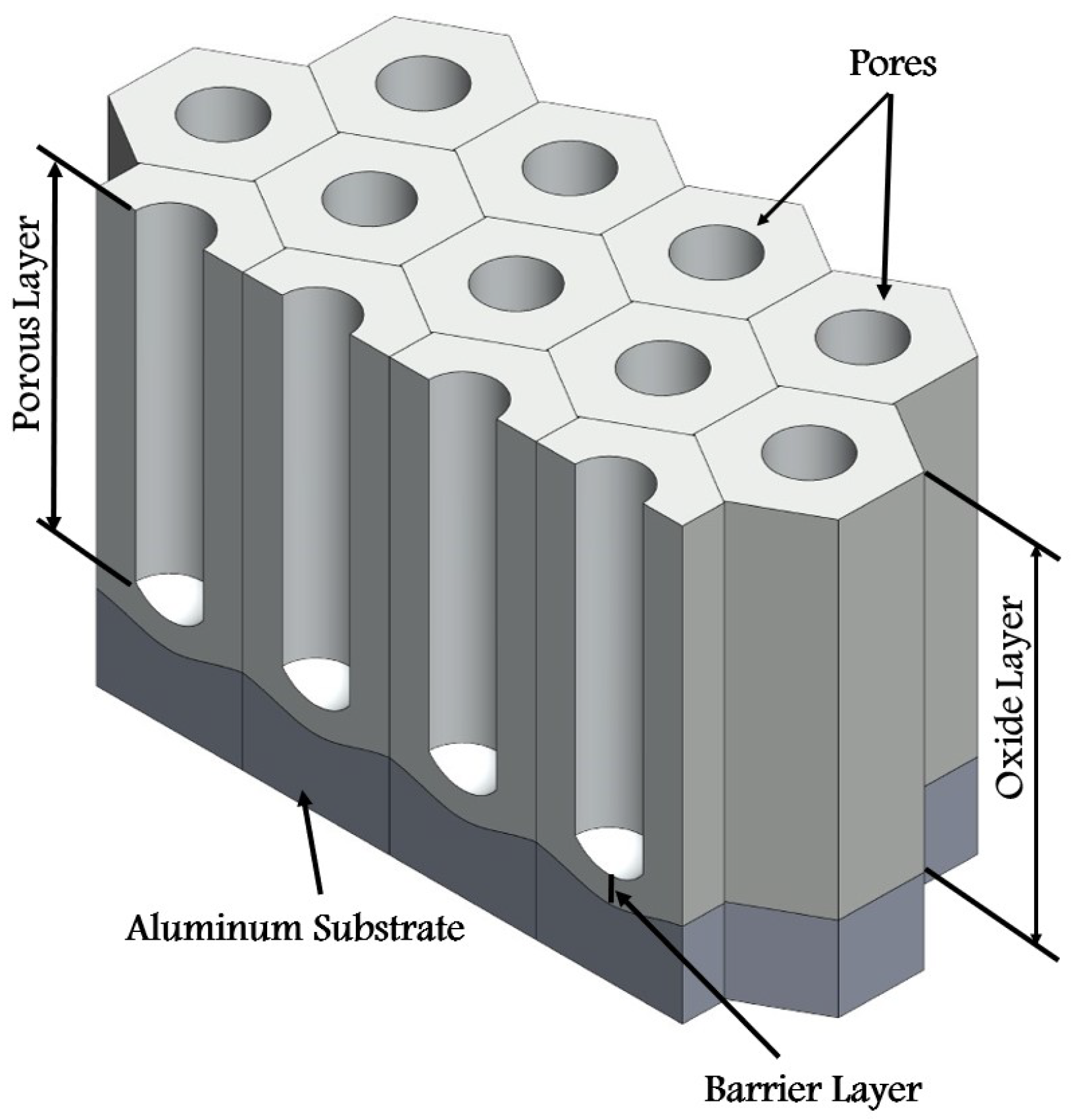

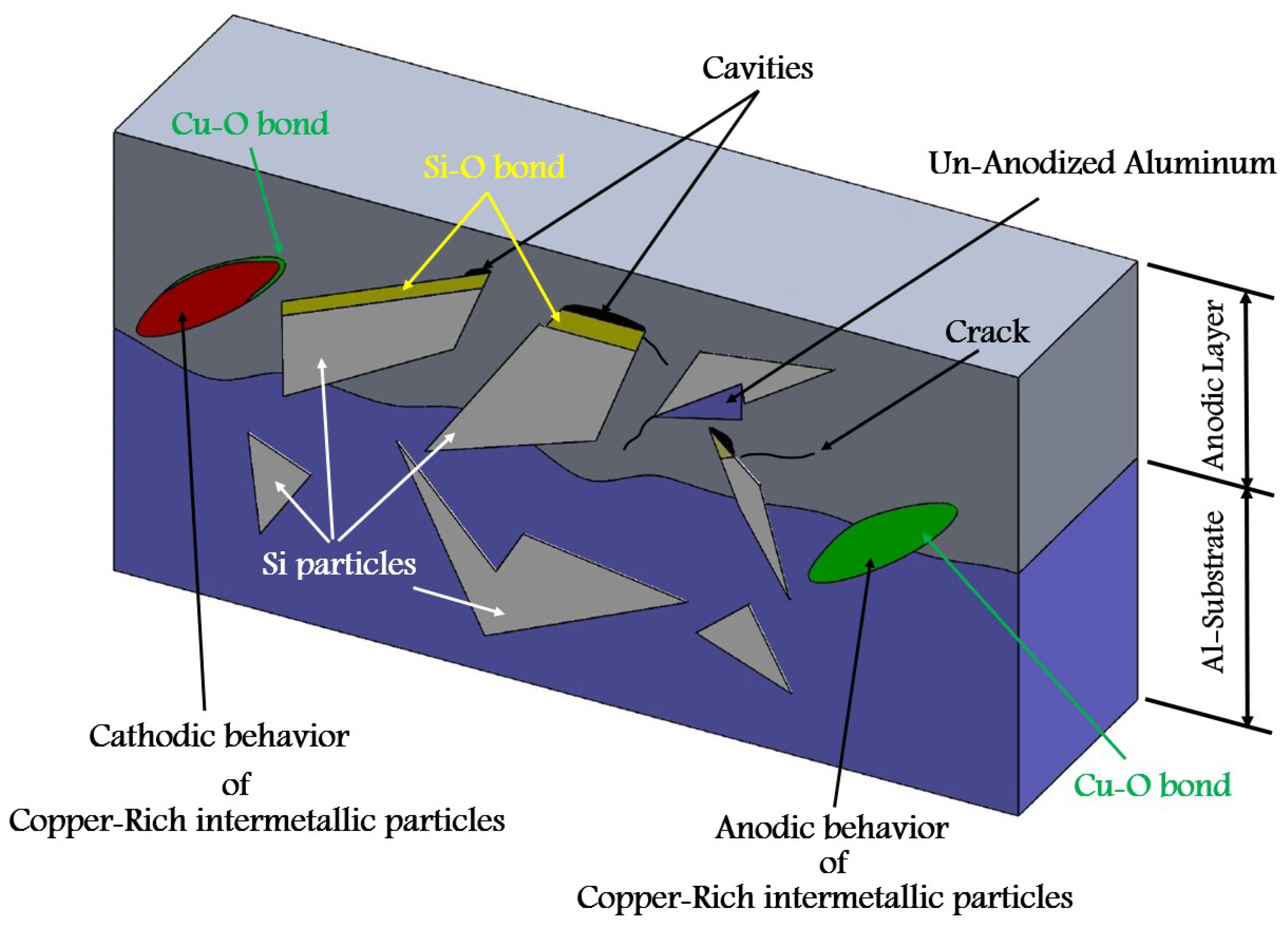
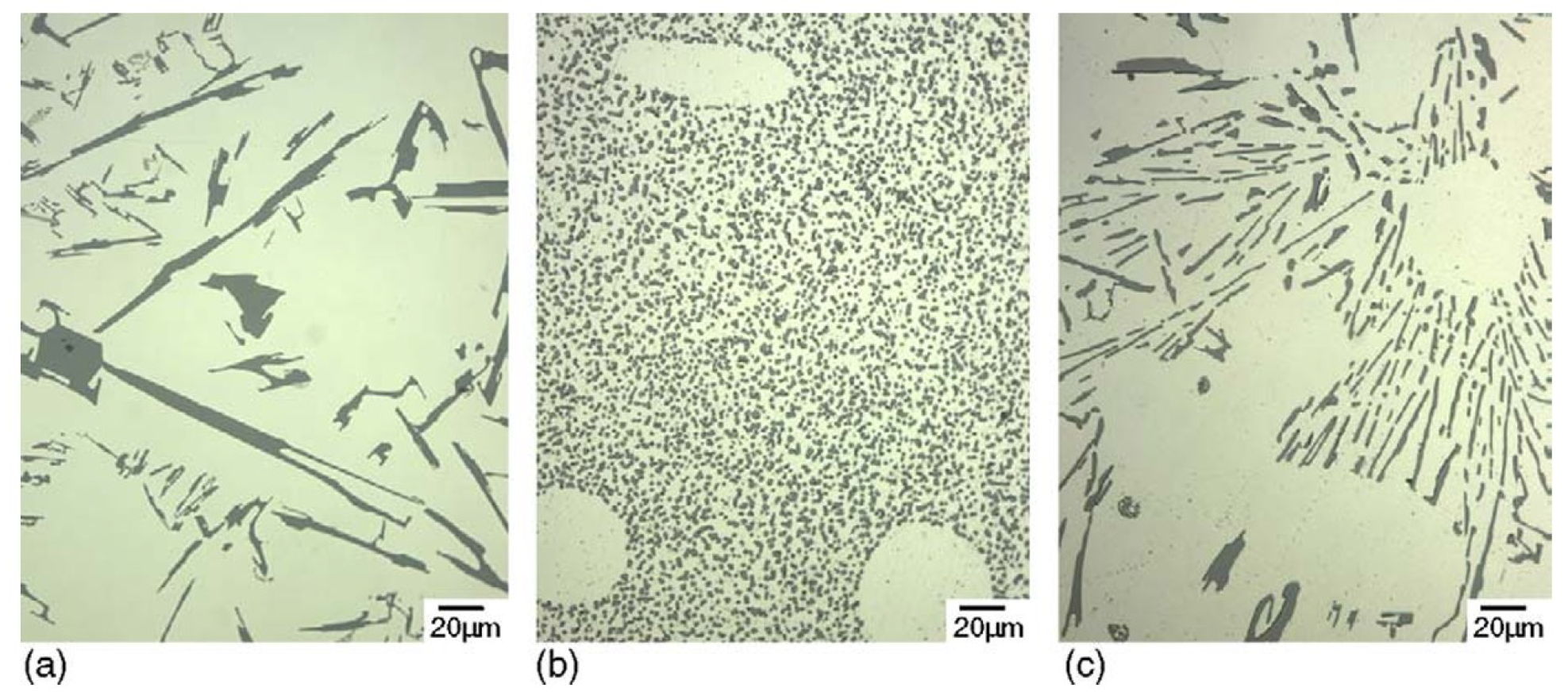
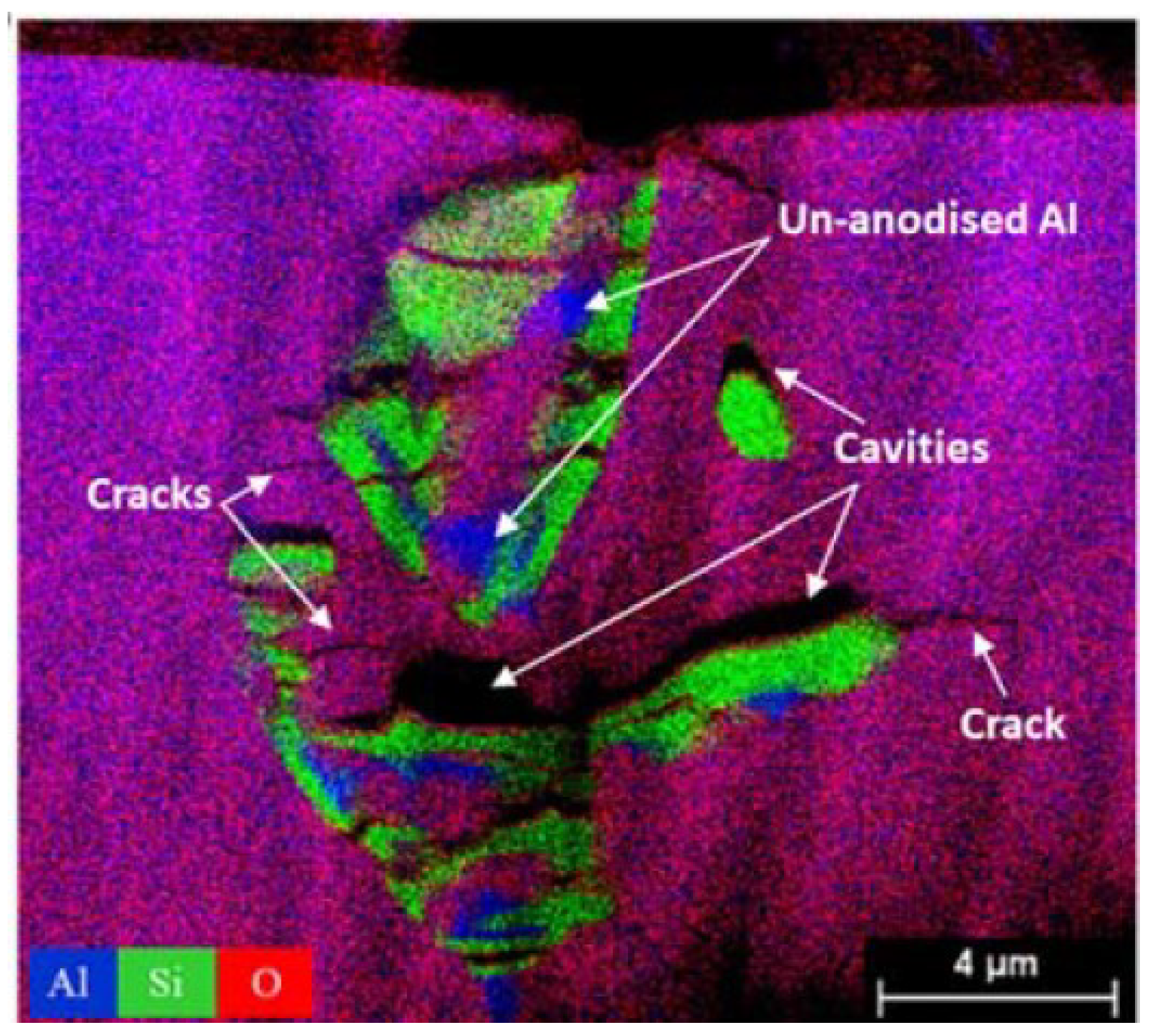
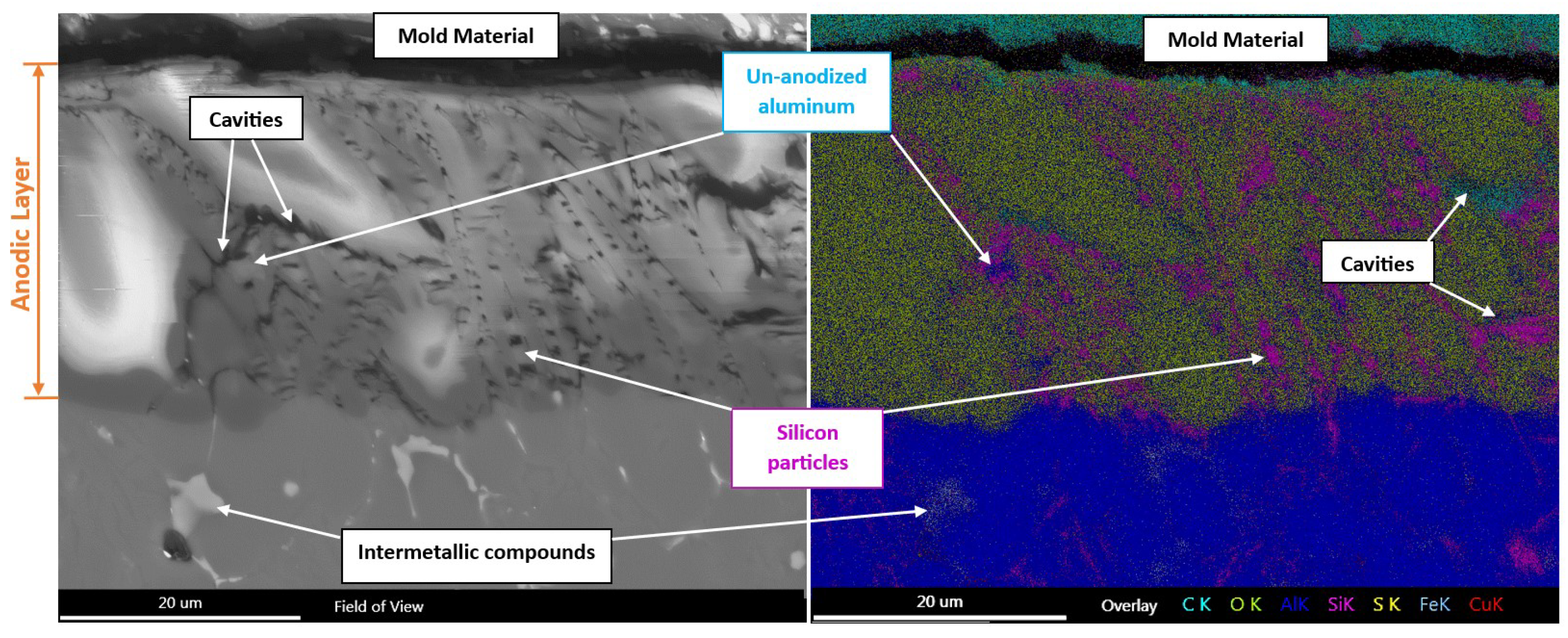
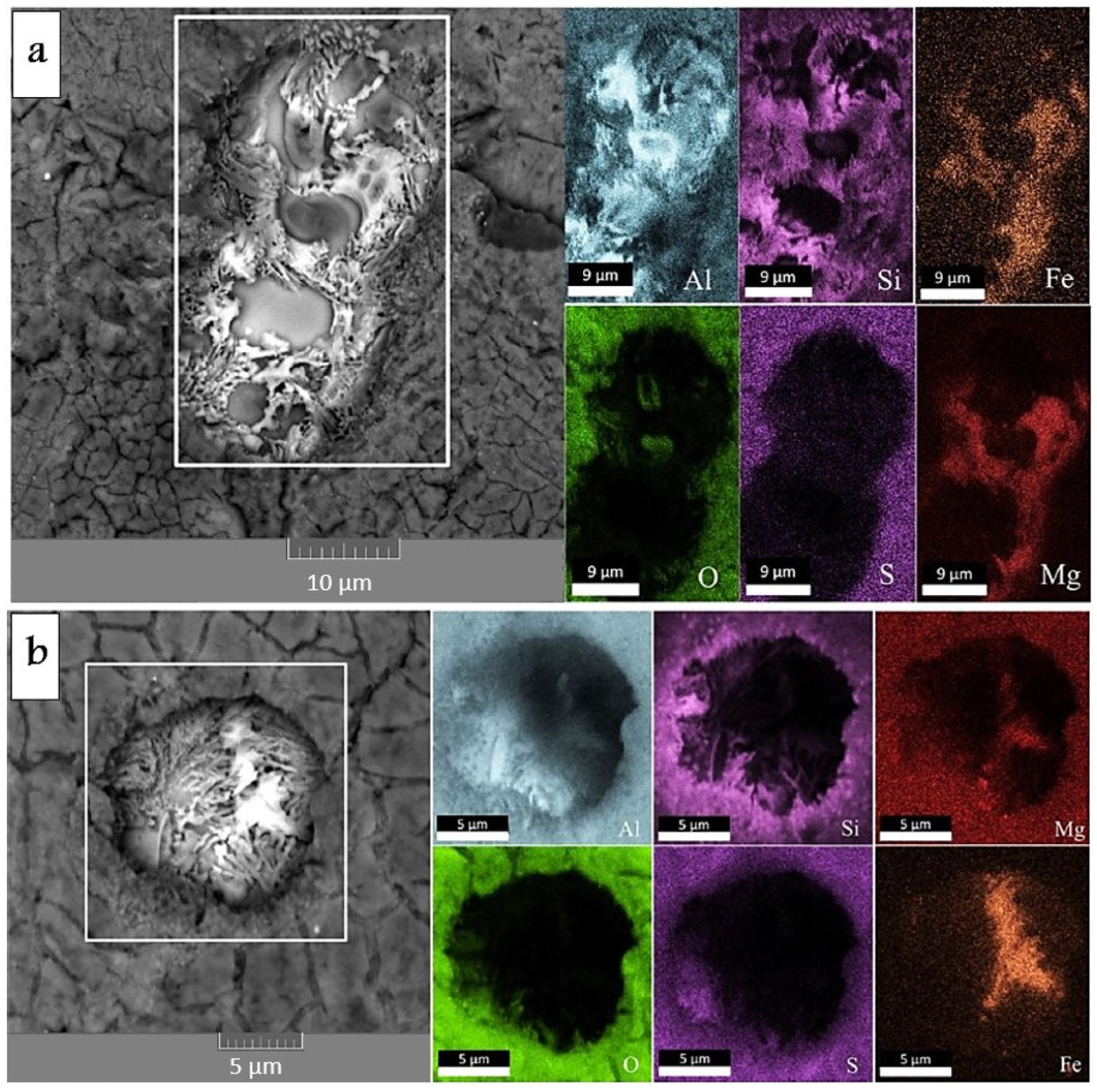
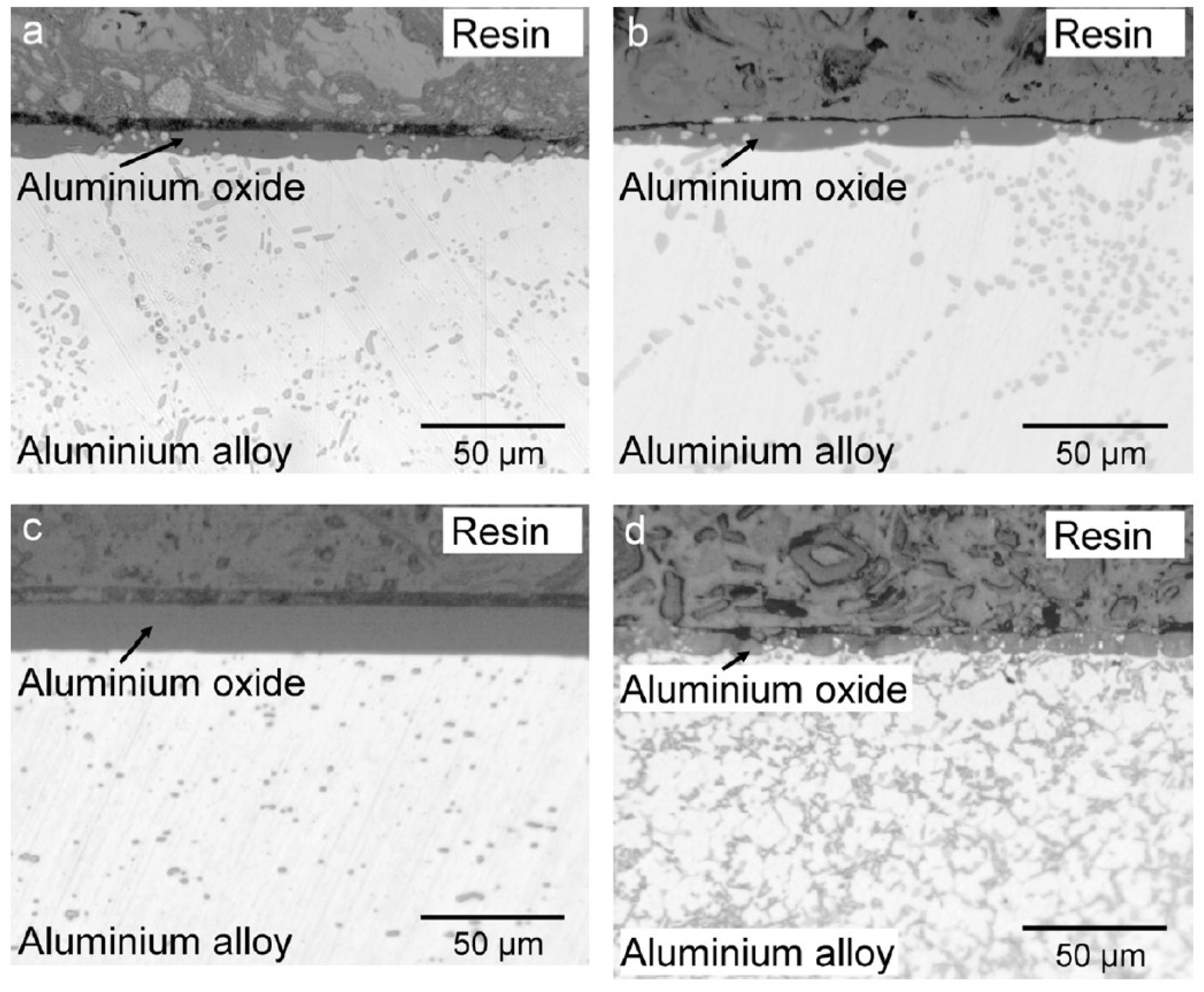
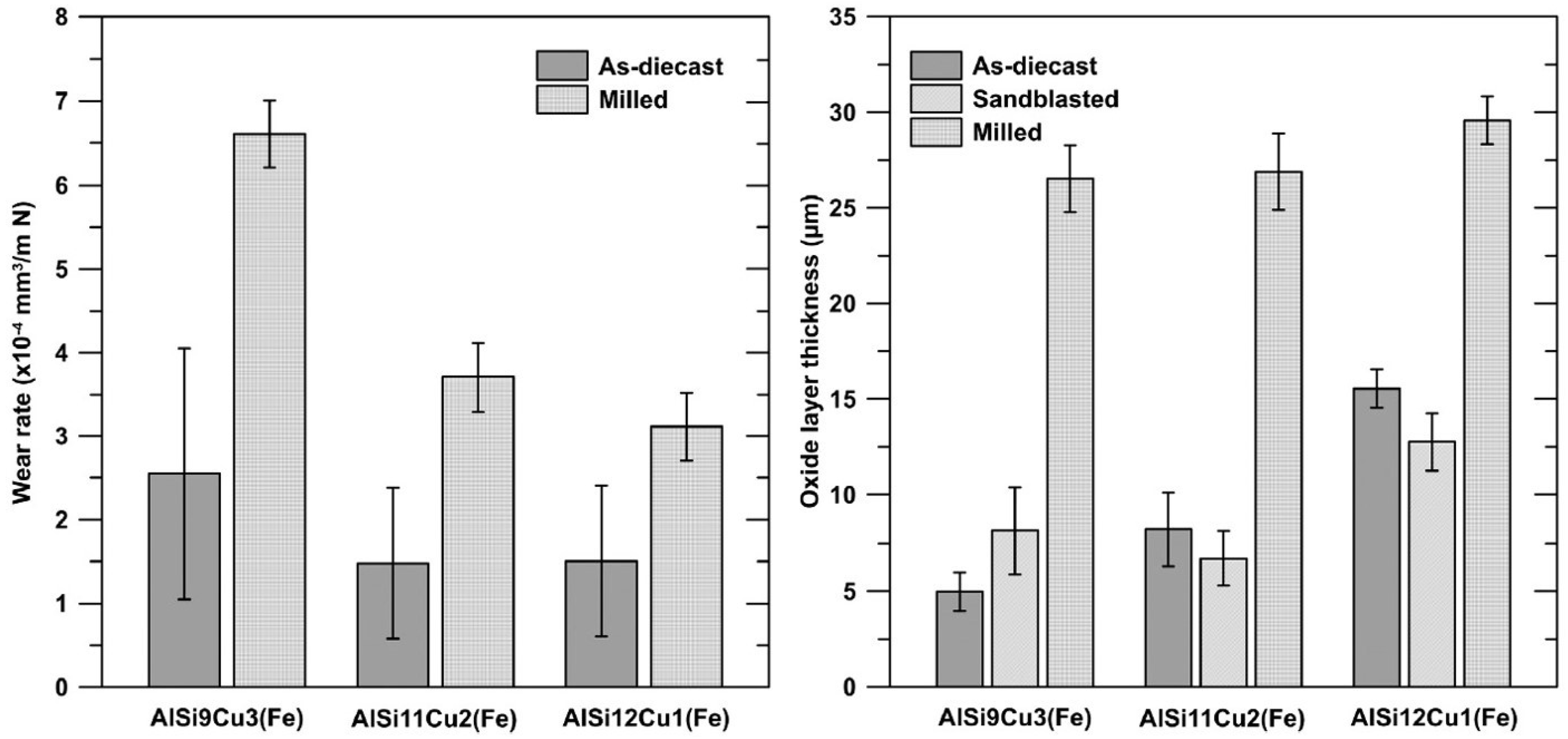
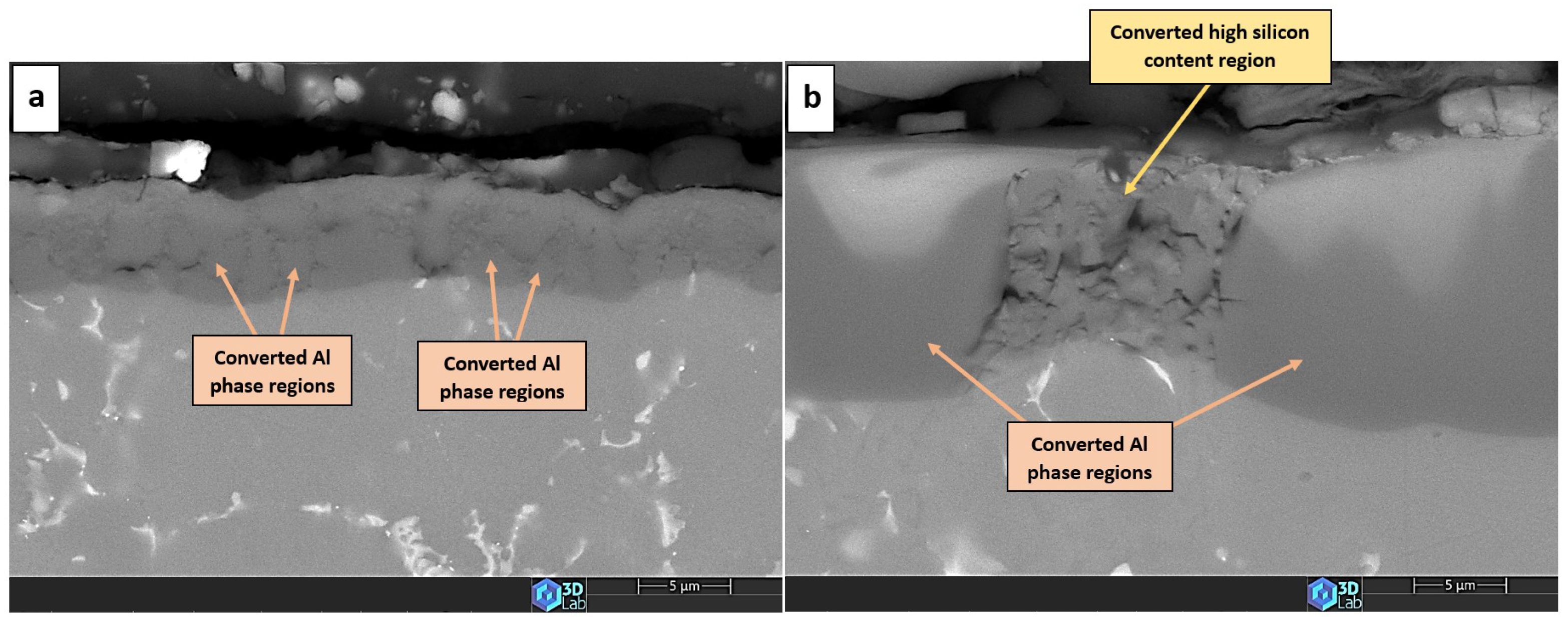
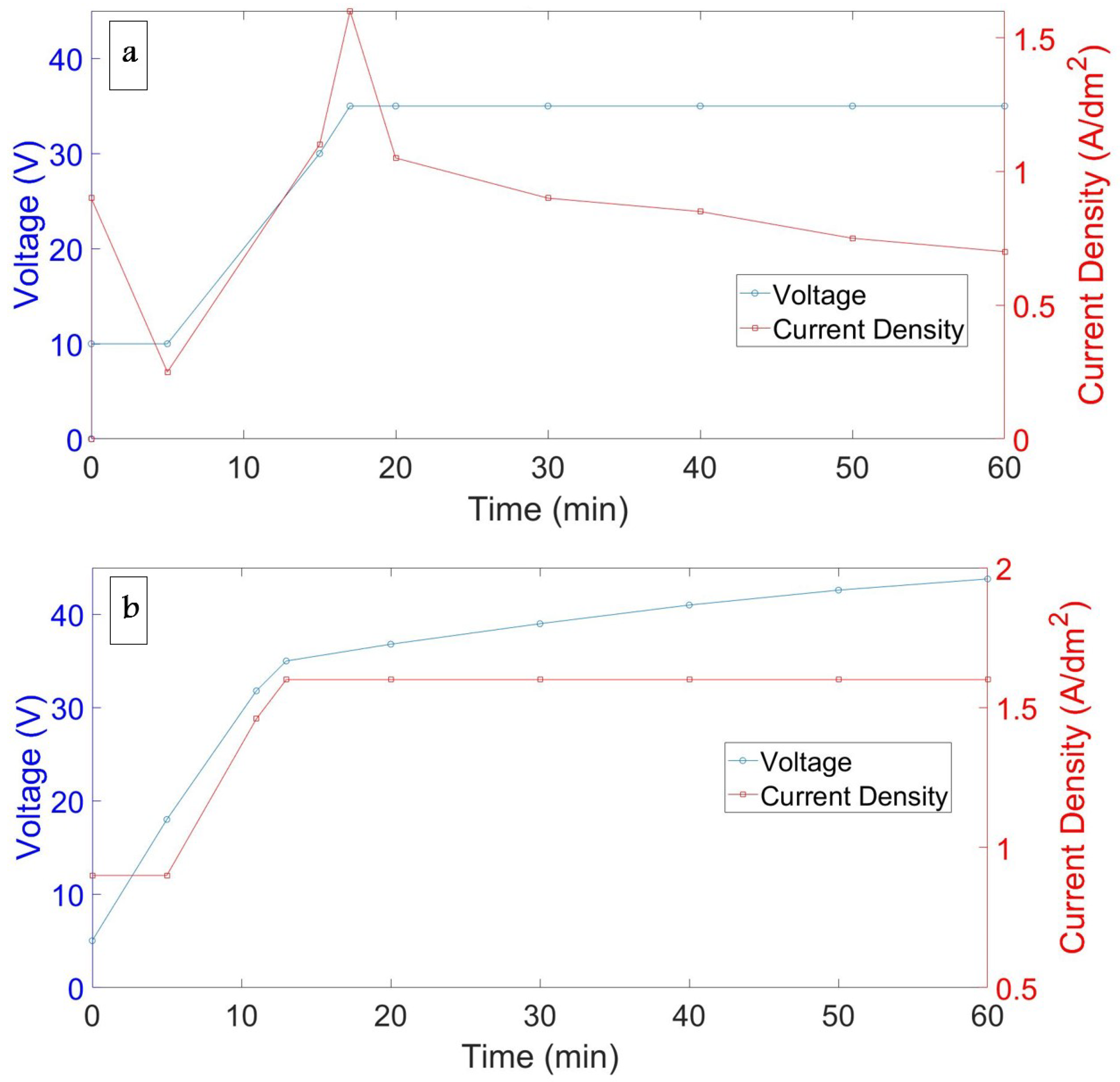
| Non-Acid | Chemical Formula | Conc., (M) | pH |
|---|---|---|---|
| Ammonium Adipate | NH4OCO | 150 g/L | 6.4 |
| (CH2)4COONH4 | |||
| Sodium Borate | Na2B4O7 | 2.2 | 7 |
| Sodium Chromate | Na2CrO4 | 0.1 | 10 |
| Sodium Hydrogen Phosphate | Na2HPO4 | 0.1 | 9.4 |
| Sodium Hydroxide | NaOH | 0.01, 0.03 & 0.1 | Not specified |
| Sodium Sulfate | Na2SO4 | 0.1 | 5.8 |
| Acid | Conc. (M) | Voltage (Volts) | Pore Size (nm) | Time (Hours) |
|---|---|---|---|---|
| 0.25 | 60 | 75 | 8.8 | |
| 0.3 | 40 | Not specified | Variable | |
| 0.3 | 40 | 80 | 8, Variable | |
| 0.3 | 40 | 50 | 10.5 min | |
| 0.3 | 60 | 80 | 3.8 | |
| Oxalic | 0.3 | 40 | 40–50 | 40 min, 2 |
| 0.3 | 40, 50 | 20, 35 | Variable | |
| 0.3 | 30 | 40 | 8, 10 | |
| 0.4 | 40 | 50 | 8, 10 | |
| 0.5 | 50 | 80 | 8, 10 | |
| 0.3 | 40 | 22 | 12, 4, 8, 12 and 16 | |
| Not specified | 195 | 200 | variable | |
| 0.4 | 5 to 40 | 20 to 75 | 1 step/variable | |
| 0.4 | 80 | 80 | 1 step | |
| Phosphoric | 0.42 | 87 to 117 | 64 to 79 | 1 step/Variable |
| 0.5 | 18 | 70 | 4, variable | |
| 2.4 | 15 to 25 | 13 to 27 | 2-step/variable | |
| Sulfuric | Not specified | 12, 25, 40 | 25, 50, 100 | Not specified |
| 0.3 | 25 | 20 | 12, 4, 8, 12 and 16 |
Disclaimer/Publisher’s Note: The statements, opinions and data contained in all publications are solely those of the individual author(s) and contributor(s) and not of MDPI and/or the editor(s). MDPI and/or the editor(s) disclaim responsibility for any injury to people or property resulting from any ideas, methods, instructions or products referred to in the content. |
© 2024 by the authors. Licensee MDPI, Basel, Switzerland. This article is an open access article distributed under the terms and conditions of the Creative Commons Attribution (CC BY) license (https://creativecommons.org/licenses/by/4.0/).
Share and Cite
Razzouk, E.; Koncz-Horváth, D.; Török, T.I. Critical Challenges in the Anodizing Process of Aluminium–Silicon Cast Alloys—A Review. Crystals 2024, 14, 617. https://doi.org/10.3390/cryst14070617
Razzouk E, Koncz-Horváth D, Török TI. Critical Challenges in the Anodizing Process of Aluminium–Silicon Cast Alloys—A Review. Crystals. 2024; 14(7):617. https://doi.org/10.3390/cryst14070617
Chicago/Turabian StyleRazzouk, Emel, Dániel Koncz-Horváth, and Tamás I. Török. 2024. "Critical Challenges in the Anodizing Process of Aluminium–Silicon Cast Alloys—A Review" Crystals 14, no. 7: 617. https://doi.org/10.3390/cryst14070617





